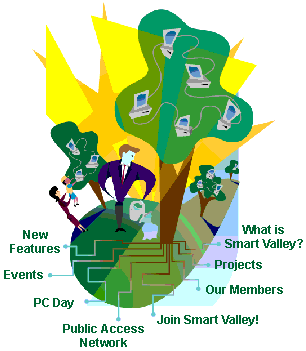
Smart Valley

Smart Valley was an initiative of Joint
Venture: Silicon Valley. Smart Valley was a 501(c)(6)
nonprofit organization focused on creating an "information
infrastructure" in Silicon Valley, California - Palo Alto, Mountain
View, Sunnyvale, Cupertino, San José, Santa Clara and the
surrounding area. Smart Valley drew its ideas and strategies from
"an association of local companies working together with the
community to coordinate people and technology with projects that
enhance the quality of life in Silicon Valley." It was founded in
1993 and its first project was regarding telecommuting. From 1993
through 1995, Dr.
Harry J. Saal served as founding CEO and President.
In an
October 1995 article in Government Technology magazine that
profiled Smart Valley, Seth Fearey, one of the directors of the
initiative, and said more than 100 people from area companies,
schools and governments, as well as private citizens, volunteered to
create the initiative. By the time of this article's publication,
Smart Valley operated with a 12-person paid staff, a budget of about
$700,000 and donated services and equipment worth approximately
$450,000. "The public sector can't sit down and talk to the private
sector without the presence of a neutral party. There are too many
conflict of interest problems. By having Smart Valley chair
meetings, those type of problems go away," said Fearey. "Our mission
is to help people understand the information highway, what it's good
for and what it's not good for. It's a complicated subject, but one
people ought to be looking into and trying to understand. We think
there are real benefits not only to the business community and
economic development, but also to the citizens and to government,
which can use it to build bridges to the citizens."
Smart Valley activities:
Education Projects "vital to preparing our children for the 21st Century and beyond":
SmartSchools NetDay II
SmartSchools PC Day
Technical Guidebook for Schools
Networking Survey of Area Schools
Challenge 2000
Community Projects
Smart Voter, to help people learn about upcoming elections
Connect 96: The Global Summit on Building Electronic Communities
Public Access Network (PAN)
Government Projects
Smart Permitting
Smart Citizen
Business Projects
Telecommuting Initiative
Smart Valley Webmasters Group - Smart Web
a monthly series of lectures, Smart Talks, that featured "leaders of the growing information infrastructure"
Affiliated Projects (many originated at Smart Valley and were spun off as independent initiatives):
ABAG, Association of Bay Area Governments
BAMTA, The Broad Alliance for Multimedia Technology and Applications
CommerceNet, "the premier industry association for Internet Commerce"
Plugged In, one of the first digital divide efforts, working to bring "the tremendous technological resources available in the Silicon Valley to youth in low-income communities" in East Palo Alto (you can see archived versions of this initiative at archive.org by searching pluggedin.org before 2012)
SV-PAL, the Silicon Valley Public Access Link, is a non-profit volunteer organization which brings Internet access to the South Bay community including local schools, organizations, businesses and individuals.
Smart communities initiatives by Helena Lindskog of the University of Linköping, Sweden
From the 1996 Smart Valley web site:
In addition to this World Wide Web server, Smart Valley maintains a host of electronic information services. For those users without access to the Web, Smart Valley publishes our most important documents on our gopher and ftp servers. For the latest news on Smart Valley and all of our projects, our members and the public are encouraged to join our electronic mail listservs. The public can read and post comments and information about Smart Valley and related subjects on the USENET newsgroup ba.smartvalley.
Smart Valley had "a vision to create an electronic community by developing an advanced information infrastructure and the collective ability to use it. We want to facilitate the construction of a pervasive, high speed communications system and information services that will benefit all sectors of the community -- education, healthcare, local government, business and the home. The infrastructure we implement will help transform the way we work, live and learn. The technologies and products we develop to build and take advantage of the infrastructure will be marketable around the world as more and more communities move into the information age."
To see the original Smart Valley web site and read more about these projects, go to archive.org and search for www.svi.org
Note: the Smart Communities Guidebook, How California’s Communities Can Thrive in the Digital Age, developed by California Institute for Smart Communities at San Diego State University and published in 1997, says
a “smart community” is simply
that: a community in which government, business, and residents
understand the potential of information technology, and make a
conscious decision to use that technology to transform life
and work in their region in significant and positive ways.
And in How California’s Communities Can Thrive
in the Digital Age, Implementation Guide, developed by the
same Institute and
published in 1997, says:
A “smart community” is a community in which
members of local government, business, education, healthcare
institutions and the general public understand the potential
of information technology, and form successful alliances to
work together to use technology to transform their community
in significant and positive ways. Because of these unified
efforts, the community is able to leverage resources and
projects to develop and benefit from telecommunications
infrastructure and services much earlier than it otherwise
would. Instead of incremental change, a transformation occurs
which increases choice, convenience and control for people in
the community as they live, work, travel, govern, shop,
educate and entertain themselves. Smart communities or regions
are also economically competitive in the new global economy,
and attract and promote commerce as a result of an advanced
telecommunications infrastructure.
Also see
"Smart
Valley: an electronic community. A vision of our future," by
H.J. Saal, paper presented at COMPCON '94, 28 Feb. - 4 March 1994.
The Public Access Network, a Wired.com article from October 1, 1995.
Release 2.1 by Esther Dyson. Crown Publishing Group, May 5, 1999. 384 pages.
"Smart
Valley, Inc.: Creating a 21st Century Community," a
presentation by Pete Sinclair President & CEO Emeritus, Smart
Valley, Inc., 1999
Civic Revolutionaries: Igniting the Passion for Change in America's Communities by Douglas Henton, John G. Melville, Kimberly A. Walesh. John Wiley & Sons, 2004. 266 pages.
 my
home page
my
home page my
consulting services & my
workshops & presentations
my
consulting services & my
workshops & presentations my
credentials & expertise
my
credentials & expertise My
research projects
My
research projects My book: The
Last Virtual
Volunteering Guidebook
My book: The
Last Virtual
Volunteering Guidebook contact
me or see
my schedule
contact
me or see
my schedule Free Resources:
Community Outreach, With & Without Tech
Free Resources:
Community Outreach, With & Without Tech Free Resources: Technology
Tips for Non-Techies
Free Resources: Technology
Tips for Non-Techies Free Resources: Web
Development, Maintenance, Marketing for non-Web designers
Free Resources: Web
Development, Maintenance, Marketing for non-Web designers Free Resources: For
people & groups that want to volunteer
Free Resources: For
people & groups that want to volunteer linking
to or from my web site
linking
to or from my web site The
Coyote Helps Foundation
The
Coyote Helps Foundation Jayne's Amazon
Wishlist
Jayne's Amazon
Wishlist me
on social media (follow me, like me, put me in a circle,
subscribe to my newsletter)
me
on social media (follow me, like me, put me in a circle,
subscribe to my newsletter)Disclaimer: No guarantee of accuracy or suitability is made by the poster/distributor. This material is provided as is, with no expressed or implied warranty.
Permission is granted to copy, present and/or distribute a limited amount of material from my web site without charge if the information is kept intact and without alteration, and is credited to Jayne Cravens, coyoteboard.com
Otherwise, please contact me for permission to reprint, present or distribute these materials (for instance, in a class or book or online event for which you intend to charge).
